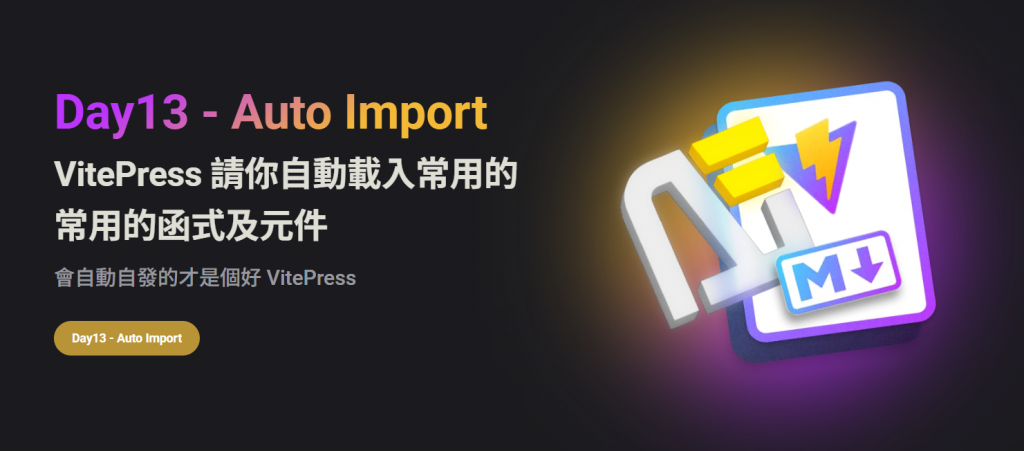
到昨天,整個環境才算是設定好了,水了 12 天了,接下來該認認真真的寫一點程式了,那我們今天來水點 Vite 的 plugin 吧 (被拖去打)
等等聽我解釋, VitePress 的其中一個很大的優勢就是建立在 Vite 上面,我們要善用他的優勢!!
我們在 docs/ 下面建立 components、data、hooks 幾個資料夾,並分別設定他們的別名:
import path from 'node:path';
export default defineConfig({
vite: {
resolve: {
alias: { // 設定別名
'@': path.resolve(__dirname, '../'), // docs 當根目錄
'@vitepress': path.resolve(__dirname), // .vitepress 目錄
'@components': path.resolve(__dirname, '../', 'components'),
'@data': path.resolve(__dirname, '../', 'data'),
'@hooks': path.resolve(__dirname, '../', 'hooks'),
'@pages': path.resolve(__dirname, '../', 'pages')
}
}
}
});
稍微大點的專案,通常會用很多 import,Anthony Fu大,根據 unplugin 做了幾個自動 import 的套件:
自動 import 常用的API,像是 vue 的 ref、computed、onMounted,第三方的 axios、vueUse 的 API 等等。
yarn add unplugin-auto-import -D
import AutoImport from 'unplugin-auto-import/vite';
export default defineConfig({
vite: {
plugins: [
AutoImport({
include: [
/\.[tj]sx?$/, // .ts, .tsx, .js, .jsx
/\.vue$/,
/\.vue\?vue/, // .vue
/\.md$/ // .md
],
// global imports to register
imports: [ // presets
'vue',
{ // custom
'@vueuse/core': [
// named imports
'useMouse', // import { useMouse } from '@vueuse/core',
// alias
['useFetch', 'useMyFetch']
],
'axios': [
// default imports
['default', 'axios']
],
'vue': ['PropType', 'defineProps', 'InjectionKey', 'Ref']
}
],
dirs: [],
dts: './types/auto-imports.d.ts', // typescript 宣告檔案位置
vueTemplate: false,
eslintrc: {
enabled: false, // Default `false`
filepath: './.eslintrc-auto-import.json',
globalsPropValue: true
}
})
]
}
});
可以看到設定裡面有個
dts: './types/auto-imports.d.ts',所以我們要記得在docs/目錄下建立types目錄。
而
eslintrc.enabled這個設定可以true一次,然後執行yarn docs:dev
可以讓她生成eslintrc-auto-import.json,
生成後改為false,除非有改動再重新生,不關掉的話每次都會重新生成,
有時候會導致ESLint抓不到文件。
自動 import component
yarn add unplugin-vue-components -D
import Components from 'unplugin-vue-components/vite';
export default defineConfig({
vite: {
plugins: [
Components({
dirs: ['./components'], // 指定components位置 預設是'src/components'
dts: './types/components.d.ts', // .d.ts生成位置
extensions: ['vue'],
directoryAsNamespace: true, // 允許子目錄作為命名空間
resolvers: [] // 解析規則
})
]
})
}
});
會看到 Opshell 把 directoryAsNamespace 這個參數設為 true,而 components 的目錄結構長這樣:
docs/components/
├─ el
│ ├─ btn.vue
│ ├─ input.vue
│ ├─ skill.vue
│ └─ svgIcon.vue
├─ mole
├─ orga
└─ template
所以他生成之後,要使用 skil.vue 好了,就會像這樣,<ElSkill></ElSkill>。
Opshell 為了偷懶,自己寫了很多 SCSS 的 @mixin,為了讓他可以全域使用,我們在 vite 裡面設定一下:
import Components from 'unplugin-vue-components/vite';
export default defineConfig({
vite: {
css: { // 共用全域 SCSS
devSourcemap: true, // scss sourcemap
preprocessorOptions: {
scss: {
additionalData: `@import "@vitepress/theme/scss/mixin.scss";`,
charset: false
}
}
}
}
});
mixin.scss只建議放@mixin$scss-var這類的 scss 宣告項,不要在裡面放入實體的 css 宣告:
body {
font-size: 16px;
}
因為會重複打包,你會發現他包出來的 body 有好幾個。
原理是你每 import 一個component(組件),他就會 import 一次mixin.scss,當你有實體的CSS(階層式樣式表)他就會重複的一直疊上去,而@mixin$scss-var等 SCSS 變數的宣告則不會有這個問題。
好了,環境的東西都處理完了,這次是真的啦,相信我!!
明天一定進入 stage 3,正式的來寫程式!
